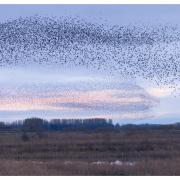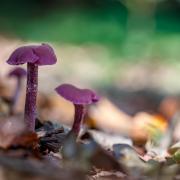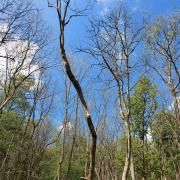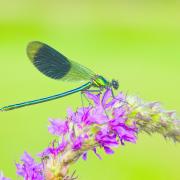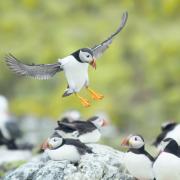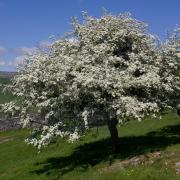A family of headbangers is preparing for a noisy homecoming for which we can all get a front-row seat this month, as Yorkshire Wildlife Trust’s Tom Marshall reports

From classic cartoons, to sitting alongside Bagpuss in a favourite childhood TV show, woodpeckers often feature on the small screen – but how many of us have seen one in real life?
There are just three native woodpeckers in the UK; and like all the most fascinating species, a generous variation in sizes – from as small as a finch to as large as a crow – make them one of most intriguing groups of birds to seek out.
While their distinctive nest-holes leave a tell-tale sign in our woodlands, seeing a woodpecker still remains a treat, and with trees shedding their leafy coats for the winter ahead, these high flyers can be easier to spot.
The most ubiquitous, and very much a regular garden visitor nowadays is the great spotted woodpecker. Sitting in the middle of the gang size-wise at about 22cm (8-9in) long, this is the Phil Collins of the woodland canopy, tapping out their distinctive echoing drum each spring, at over 20 times a second.

With most of us likely to get a migraine just thinking about that amount of head-banging, the woodpecker in contrast, is ideally suited. A reinforced skull and an array of special muscles and elastic tissues provide the perfect set of natural shock absorbers for an action so intense that it’s barely visible to the human eye.
Health and Safety is firmly on the agenda too, with tough eyelids closing milliseconds before the beak strikes, shielding the delicate retina and stopping eyeballs flying out under the force. Even breathing is maintained for maximum effect, with feathery nostrils designed to deter even the smallest of wood chips.
Alongside hundreds of drumming sessions each day which may start as early in the year as January or February, great spotted woodpeckers also indulge in dramatic chases from trunk to trunk as they search out a partner, or to see off would-be rivals.
They share a mostly black and white attire with their smaller counterpart (the lesser spotted), with the adults told apart by just the smallest of red patches at the back of the head.

Youngsters fresh out of the nest in spring are graced with a more extensive red ‘cap’, however this is lost as they approach adulthood, with just the tell-tale neck spot remaining on the males.
Rather smaller in stature at just 15cm (6in) the lesser spotted woodpecker’s elusive habit has made it a challenge to monitor, with conservationists now fearing it may be at high risk from population decline and placing it on the most concerning ‘Red List’ of species.
It’s thought there may be as few as 1,000 pairs of this sparrow-sized woodpecker left in the UK, less than 1% of the population of its more abundant and larger cousin.
Another keen percussionist, albeit with slightly less vigour, the ‘lesser spot’ prefers to stay to the upper reaches, often venturing onto outer branches that would bend at the arrival of their weightier canopy mates.

Boasting a bold lemon-green body and bright red cap, the largest of our woodpeckers – the green woodpecker, could be considered a show-off, yet can remain equally elusive to track down.
A bird of parkland with mature trees and more open country, the green woodpecker trades the chance to drum for an unmistakable laughing call – leading to its place as Professor Yaffle alongside Bagpuss. Although distinctive in its call, the green woodpecker rarely seeks out a prominent stage, with a view in flight just as likely as spotting one in a tree. The green woodpecker also bucks the trend with its eating habits – it’s a regular ground-based diner with ants a particular favourite.
The two spotted woodpeckers take a more conventional approach to mealtimes, pulling off bark or manipulating a disproportionately long tongue into cracks and crevices in search of invertebrates. However, a liberal smearing of fatty seedcake or lard onto a garden stump can prove equally attractive in your back garden.
While green woodpeckers remain largely solitary for much of the year, a useful tip for autumn and winter can be to track down a mixed feeding flock of tits and finches when looking out for both great or lesser spotted woodpeckers.

These roving groups – looking for safety in numbers and shared knowledge on food availability – often find woodpeckers among them, so check main woodland trunks for great spots and the delicate outer braches for the lessers.
All of our woodpeckers share a similar flight style; rapid beats followed by a burst with their wings tucked in, leading to an undulating, bouncing appearance.
Famously tried by Sir David Attenborough in one of his many documentaries, you may even be able to entice a curious woodpecker yourself, by rapidly drumming on hollow trees with sticks – previous experience in a rock band is not essential.
Is it or isn’t it?
There are two other woodland residents capable of impressive tree climbing – the superbly camouflaged treecreeper is tiny (just 12cm/5in long) and will often fly low to the ground before exploring upwards, repeating the process throughout the forest.
The delightful nuthatch is similar in size to a lesser spotted woodpecker but has a bulkier appearance and striking sky-blue and apricot-orange plumage. Unmistakeably, the nuthatch can also climb headfirst, a skill not shared by our woodpeckers who all have to go backwards. It is also something of a fan of home improvement, choosing to use mud to seal up larger nest holes to its own exacting requirements each spring – a strategy even repeated on perfectly-sized nestboxes!










